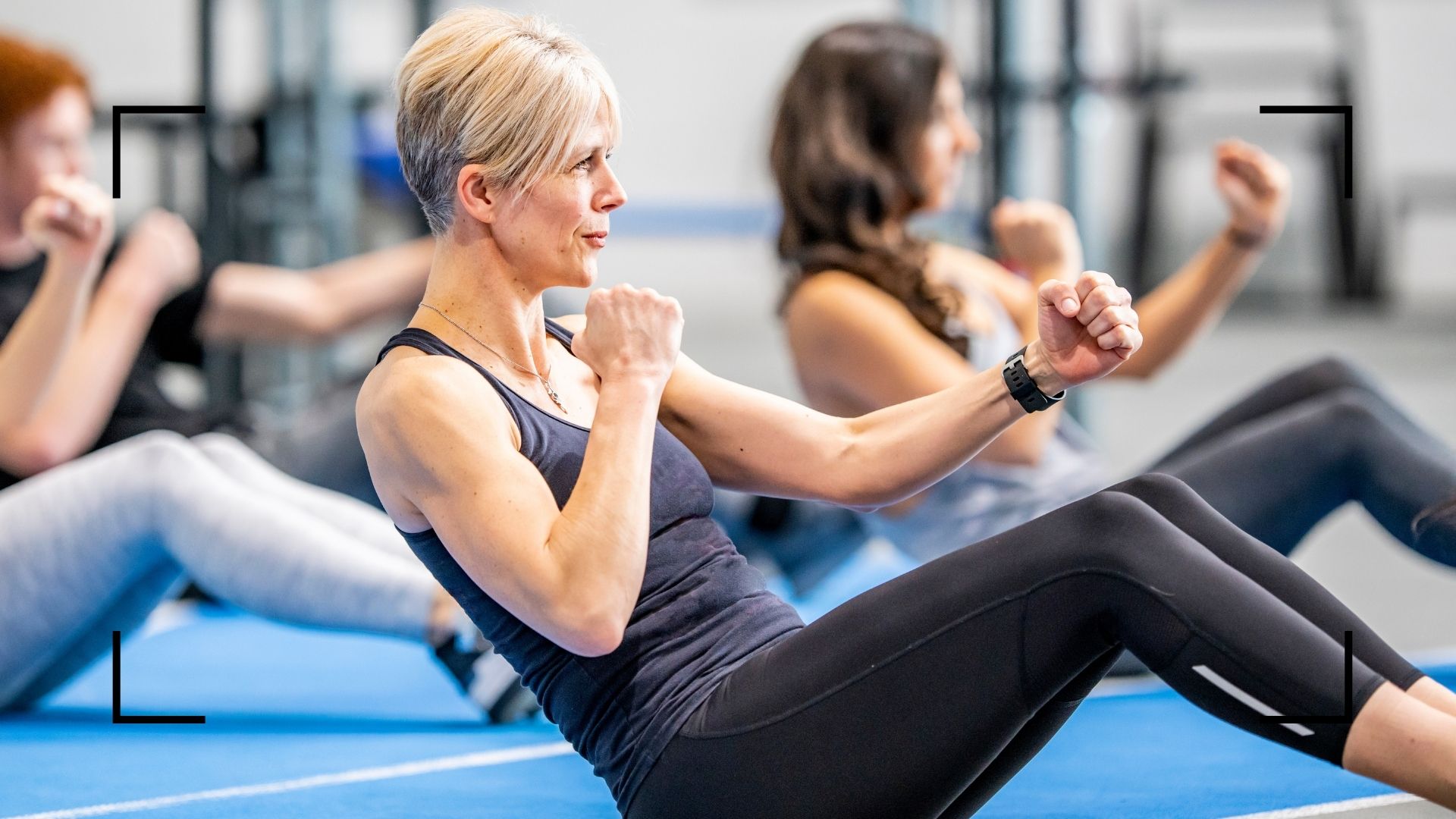The best ab workouts for women, at home and in the gym
These ab workouts for women will help develop core strength and improve fitness levels overall


The best ab workouts for women engage and strengthen each of the three core muscles—the abdomen (six-pack), obliques (side muscles from your ribs to your hip), and the transverse abdominus (the lower ab muscle that wraps around and supports your spine).
From the age of 30, an individual loses roughly 3-8% of muscle mass each year. This decline in muscle mass speeds up again during your 60s. However, whether you are new to ab workouts or dreaming of the ab definition you had in your 30s, it’s never too late to focus on your core as muscles respond to exercise at any age with consistent work and it's an important part of fitness for women.
The best way to develop your abs is to work on them in isolation, which will also improve your overall stability and core strength for additional exercise such as cycling workouts, HIIT, running, and at-home workouts.
The benefits of ab workouts for women over 40
The benefits of ab workouts for women over 40 improving not only your core strength, but improving posture, preventing injury, and reducing your risk of lower back pain. Personal trainer Gina Obeng adds that core exercises and strength training are “great for stability, balance and can help with daily activities” for women over 40.
Dr Oluwajana outlines that regular ab workouts ab can also counteract the effects of pregnancy and childbirth on women’s bodies, which weaken your core and pelvic floor muscles (if this is a concern, you may want to take a look at our guides on kegel exercises, and best pelvic floor trainers).
The best ab workouts for women at home
The best ab workouts for women at home are those that utilize your own body weight to increase the intensity of the workout. Remember that the key to feeling the benefit of each of these exercises is to be consistent and gradually increase to a more difficult variation of the exercise in order to prevent injury.
Forearm plank
Dr Folusha Oluwajana, an NHS GP and personal trainer, says, “The plank is a classic core strength and stability exercise that particular targets your deep core muscles, transverse abdominus.” It also has the added benefit of engaging and strengthening your shoulders, lower back, glutes, and quads.
Sign up to our free daily email for the latest royal and entertainment news, interesting opinion, expert advice on styling and beauty trends, and no-nonsense guides to the health and wellness questions you want answered.
- Start by lying on your front, forearms below your shoulders.
- Tuck your toes and whilst engaging your core and pelvic floor, glutes, and quads, lift your body and knees of the floor.
- Keep your tailbone tucked so your body forms a straight line from your head to your feet and your shoulders should be directly above your elbows.
- Hold for as long as possible or desired, and then lower back to the floor.
- You can also perform this on your side on one forearm to move the focus to your obliques.
Reverse Crunch
This exercise will target your “six pack” muscles or the rectus abdominus. This variation of a regular crunch will intensify the movement to give you maximum results.
- Start lying on your back on the floor, with your knees bent.
- If available, hold onto something stable just above your head, like a heavy table leg to stabilise yourself.
- Slowly lift your hips off the floor by flexing your spine and bringing your hips towards your chest. Keep your shoulders on the floor.
- Lower back down to the start position with control.
Deadbugs
Dr Oluwajana continues: “Deadbugs are an excellent low impact exercise targeting your deep core muscle and pelvic floor.”
- Start lying on your back, with your arms extended towards the ceiling above your chest and your feet off the floor and knees bent at 90 degrees. Inhale.
- As you exhale, brace your core by contracting your transverse abdominus and drawing your pelvic floor up.
- Simultaneously lower one arm and the opposite leg towards the floor so they form a straight line with your body.
- Do not let them touch the floor.
- As you inhale, relax your core and pelvic floor and return to the starting position.
- Repeat with the opposite arm and leg.
Russian twists
This rotational movement is popular for training abs, as it’s an effective way of challenging your core and shoulders. Don’t be fooled by how simple the move looks, it requires a considerable amount of balance, strength and stamina to be completed correctly.
- Sit on the floor with your legs extended and your knees bent.
- Elongate your spine to a 45-degree angle from the floor and either raise your feet from the floor to make a V shape with your body or keep them on the ground.
- Reach your arms out in front of you and interlock your fingers.
- Twist your upper body to the left, then twist back to the center before repeating on the right side.
- Repeat 8 to 15 times for 3 sets.
- Once you’re comfortable with this movement you can always add extra resistance and hold a dumbbell (see our guide to the best dumbbells for top recommendations).
Leg raises
Lying down leg raises target the top of your ab muscles, by utilizing your own body weight and the strength required to support raising your legs. Personal Trainer, Emily Killick explains, “This exercise help to maintain posture and helps the muscles in your pelvis, lower back, hips, and abdomen to work in harmony.”
- Lie on your back with your legs straight together.
- Keep your legs straight and slowly lift them all the way up until your feet are in line with the ceiling. Gently raise your bottom of the floor.
- Slowly lower your legs back down to the floor.
- Repeat.
- If you’re struggling with this movement, place your hands underneath your bum to stabilize yourself as you raise your legs.
The best ab workouts for women in the gym
In the gym, the best ab workouts for women offer more variety than those home workouts by making the most of the machines and additional equipment on offer. In addition, ab workouts at the gym give you the opportunity to increase the intensity of your at home workouts too, by incorporating weight plates, dumbbells or cables into the movement. If you're unsure where to begin in the gym, check out one of the best workout apps.
Cable Rope Crunch
A cable rope crunch is a variation of the traditional crunch to add additional weight and resistance to really challenge your core muscles. Dr Oluwajana adds, “This exercise allows you to load spinal flexion with the weight of the cable machine and really build that six-pack!”
- Start kneeling in front of a cable machine, hold the rope attachment with each hand behind your head.
- Flex your spine against the resistance of the cable, crunching your chest down towards your pelvis and keep your chin tucked.
- Then return to the start position with control.
Decline Bench Crunch
As another variation of the crunch, this movement uses gravity to increase the resistance of the movement and target your rectus abdominus muscle.
- Start by lying on the decline bench with your head at the lower end and feet bent over the top.
- Place your hands on either side of your head or crossed on your chest.
- Bring your head and shoulders off the bench and crunch them towards your knees.
- Lower back down slowly to your starting position. Repeat.
- The intensity of this movement can be increased by adding dumbells.
Palloff Press
A Palloff press targets your transverse abdominus and obliques by pulling the cable from one side of your body to the other.
- Start standing with feet shoulder width apart, perpendicular to a cable machine or long resistance band at chest height.
- Hold the cable or band in both hands at your chest. Inhale.
- As you exhale, engage your core, pelvic floor and glutes and push the cable or band straight out in front of you until your arms outstretched, resisting its pull.
- Inhale and return to the start position.
Hanging leg raises
Instead of lying on the floor and raising your legs, now you’re going to extend your legs out in front of you as hang from the pull up bar.
- Stand shoulder width apart, reach up and grip onto the bar above.
- Hang from the bars and slowly raise your straight legs to form a 90 degree angle.
- Lower your legs till your feet are back facing the floor.
- Repeat the movement 8 to 15 times and do 2-3 sets.
Weighted V Ups
Weighted v ups are a great way of engaging your core with slightly more weight than just your own body. It’s a simple but difficult movement that requires a lot of ab strengthen and balance.
- Lie with your back to the floor and legs extended with one dumbbell held in your hands.
- Raise your straight arms and legs to meet over your stomach and form a V shape.
- Lower your arms and legs back to the floor.
- Repeat the movement 8 to 15 times for two or three rounds.
If you haven’t tried this movement before, you can always to a V up without weights first to add grow in confidence before adding additional weights.
woman&home thanks Dr Folusha Oluwajana, an NHS GP and personal trainer and Personal Trainer, Emily Killick for their time and expertise.
Jess Bacon is a freelance journalist, blogger and former editor with over six years of writing experience. As a screenwriter and journalist, Jess is keen to tell her own and other people’s stories through words, photos and film. She’s passionate about discussing young people's mental health, grief and feminism in life and how it's portrayed in the media, film and literature. Alongside her by-lines at renowned publications, Jess regularly speaks at charity events and festival panels about loss, mental health and Marvel. Along with her love of writing, Jess is an avid reader, spin enthusiast and dog-lover.
